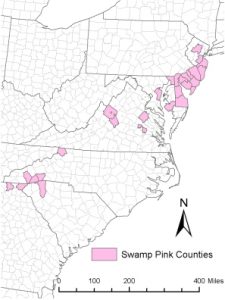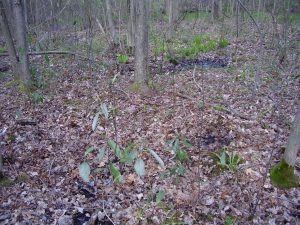It’s time for another season of swamp pink (Helonias bullata) surveys. If your project site will require wetlands permitting and is within or near known swamp pink habitat, you can minimize impacts to your project schedule by having Wetland Studies and Solutions, Inc. (WSSI) conduct a swamp pink habitat evaluation or survey early in the development process – preferably during the April 15 – May 31 survey window or during the June 1 – September 30 window.
This perennial member of the lily family is federally-threatened and state-endangered in Virginia, Maryland, and North Carolina. With this status, the U.S. Army Corps of Engineers (COE), the Virginia Department of Environmental Quality (VDEQ), the Maryland Department of the Environment (MDE), and the North Carolina Department of Environmental Quality (NCDEQ) must each consider impacts to the swamp pink before issuing permits to impact wetlands and other jurisdictional waters.

Augusta, Nelson, Caroline, and Henrico Counties (VA); Anne Arundel, Cecil, and Dorchester Counties (MD); Ashe, Henderson, Jackson, and Transylvania Counties (NC)
According to the U.S. Fish and Wildlife Service (USFWS), swamp pink has been recorded in specific counties in Virginia, Maryland, and North Carolina (see map).
WSSI has several USFWS-approved surveyors for swamp pink on staff, and we have conducted numerous swamp pink habitat evaluations and surveys throughout the Mid-Atlantic. We can conduct preliminary (and relatively inexpensive) site evaluations at any time of year to determine whether there is potentially suitable habitat for swamp pink on your project site – and for some sites, this habitat evaluation may be all that is necessary to confirm absence of the species.
On sites where suitable habitat exists, USFWS guidelines recommend that we conduct a swamp pink survey between April 15 and May 31 when the species is in flower, or between June 1 and September 30 when basal leaves are present. Surveys are valid for five years, and the USFWS may request that the site be re-surveyed if not developed during this five-year period.
Keep the Swamp Pink from Delaying your Wetlands Permit!
Contact us to schedule your swamp pink survey now and keep this species from delaying your wetlands permit. We can help you determine whether your project site encompasses swamp pink habitat, and can conduct a habitat evaluation or survey to confirm the absence or presence of the species. For more information about swamp pink please reach out to one of our contacts below.
More About Swamp Pink

typical swamp pink habitat
Swamp pink has dark green leaves that form an evergreen basal rosette. In spring, some plants will produce a flowering stalk up to 3 feet tall that is topped by a 1- to 3-inch cluster of 30-50 small, fragrant, pink flowers. The evergreen leaves of swamp pink can be seen year-round, and flowering occurs from April to May.
Swamp pink is often found growing on the hummocks formed by trees, shrubs, and sphagnum mosses, and in central Virginia and eastern Maryland generally grows in forested wetlands with canopy cover between 20 and 100 percent. While most known colonies of swamp pink are in Delaware and New Jersey, the species could be present at other locations throughout Virginia, Maryland, and North Carolina.
Plants often found with the swamp pink include sweetbay magnolia (Magnolia virginiana), sphagnum mosses (Sphagnum spp.), cinnamon fern (Osmunda cinnamomea), skunk cabbage (Symplocarpus foetidus), and laurels (Kalmia spp.).
